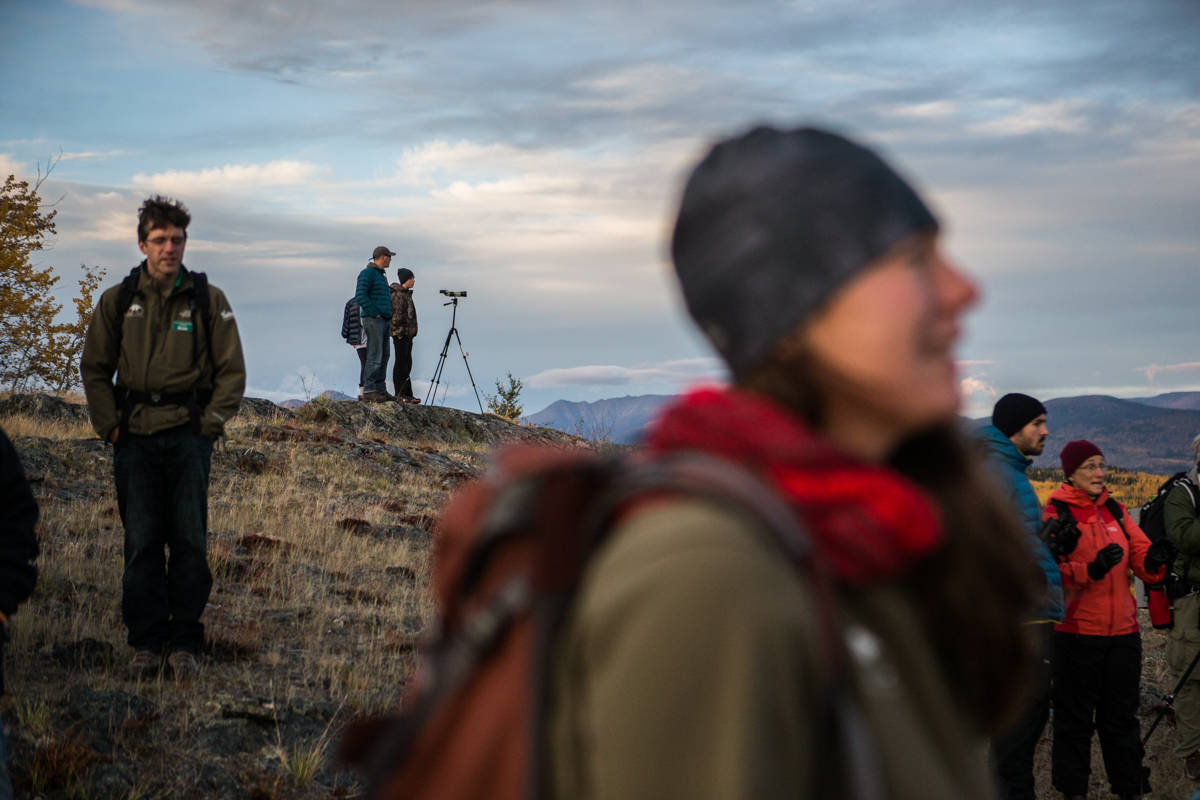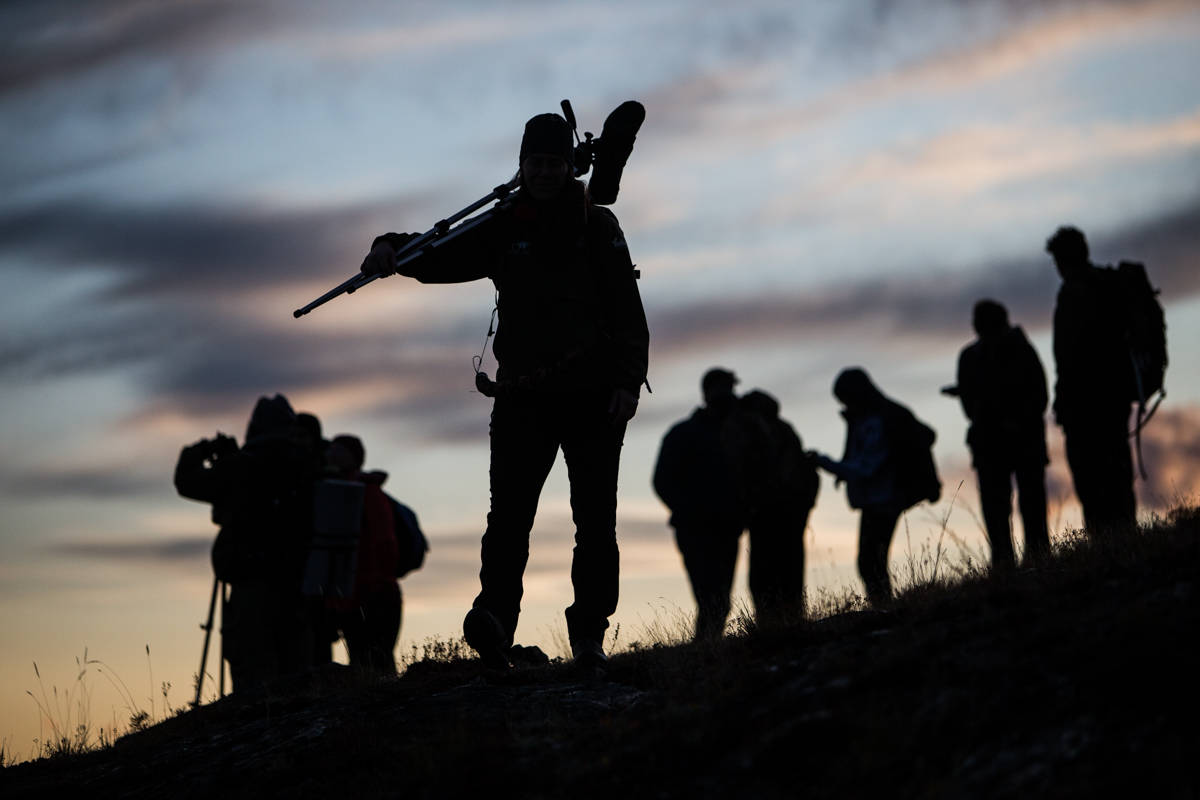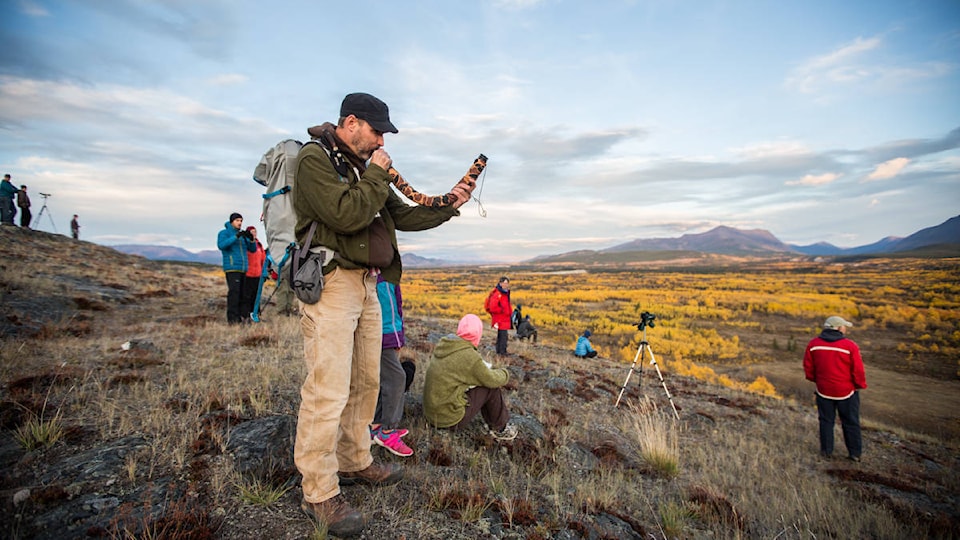The dozen or so people on the lower bluff all suddenly stopped talking and turn in place to gaze at the upper bluff. Another group of people is standing there, faces obscured by the sun, which is setting slowly behind them. They have stopped talking. Everyone is listening. From somewhere in the distance comes a sound like an old mattress squeaking, an out-of-tune trumpet or a small engine revving too high and too fast. It’s coming from very far away, but it carries across the flats from along the Takhini River.
“Was that one?” someone asks.
“I think so,” says Environment Yukon wildlife viewing biologist Carrie McClelland, “I don’t know for sure. It’s far away, if it is.”
To her left, her friend, Michael Pealow, pulls the elk call to his mouth. A long, flexible plastic tube with a camo print cloth covering, it has a reed inside, like a clarinet. Pealow takes a deep breath, leans back a little and blows into it. The noise that emerges is high and grating, deeper at the beginning and thinner and more shrill at the end — a lot like the noise we just heard somewhere in the treeline, although perhaps not quite the same.
There’s a hush as everyone waits for a return call. After a few long moments, none comes. Pealow blows the call again but the moment seems to be gone. People resume their motions, talking quietly amongst themselves, looking out over the valley through binoculars, sitting on the crisp brown grass. About 30 people have turned out to bugle — the practice of using a call to draw in elk — on a fine night Sept. 22.
Pealow tries it again.
“He’s a musician, not a biologist,” McClelland says, pointing at Pealow. “You have to have a good embouchure.”
An embouchure is the way you purse your lips to play a brass instrument like trumpet. It can also mean the place where a valley opens out onto a plain, which describes the Takhini elk herd’s habitat rather perfectly: bounded on all sides by mountains, dotted by tumbling bluffs and spilling out into a flat country which seems unusual for the Yukon. The area burned in a forest fire in 1958, McClelland says, which is part of what makes it such excellent elk habitat, because the plants that grew back after the fire provide them with food and protection.
Environment Yukon has been holding elk bugling and viewing events for the last 10 years. This wildlife viewing event is the last one of the season, says wildlife viewing technician Scott Cameron.
“Hopefully we’ll see and hear male elk bugling, which is the vocalization elk make during mating season,” he says.
Male and female elk live separately for most of the year, Cameron says, but come together in the fall — as the weather begins to get colder — to mate. Bull elk control a ‘harem’ of multiple cow elk, with whom they mate during the rutting season.
But rival males may come to try to take a male’s harem, resulting in the dramatic head-to-head battles typically associated with the species. The bugle of a bull elk is both a pick-up line for the lady elk, who are drawn in by the call, and a challenge for rival males, Cameron explains.
“That call means (for males) ‘Hey, this is my area, this is my harem, stay away,’” he says. “Males defend their harems, and females respond to the call.”
“Nothing is similar (to the bugle of an elk)…. Only elk make this vocalization.”
Elk are the second biggest member of the deer family in the Yukon, Cameron says — only moose are larger. Cows that mate successfully will have one calf per season, weighing about 15 kilograms, with twins being “fairly rare.”
The Takhini elk are not actually native to the Yukon (although a species of elk did live here during the Beringian period, he notes) but were introduced from stock from Elk Island National Park in the 1940s and 1950s by the government at the behest of the Yukon Fish and Game Board, in order to take hunting pressure off of moose and caribou, Cameron said, but the population “never really took off.”
The estimated population of the Takhini herd is 229 animals.
“They’re here in small numbers,” he said. “There’s hundreds of thousands of caribou, tens of thousands of moose, and only a few hundred elk. They exist on a different magnitude.”
A sudden short, sharp snorting sound makes everyone stop and turn abruptly.
“Sorry,” Pealow says, holding up the call and grinning sheepishly. “That was just me.”
They definitely heard some elk bugling when they first arrived at the watch site, says McClelland, but “it was so windy, and I was so bad (on the caller), maybe I scared him away.”
“Maybe I was just too good, though? Maybe he thought I was just too big and awesome and was like ‘I’m not going to mess with that guy,’ and ran away,” she adds with a laugh.
People move up onto the higher bluffs to see if they can get a better view of the valley. The incline is steep and some folks stop for a rest on their way up, sitting amid the dried-out sage and scrubby rose bushes. It begins to get dark and cold and the event begins to disperse. McClelland sighs.
“The sunsets on another season of wildlife viewing — how sad without seeing any elk,” she says. “It’s kind of a crap shoot with these wildlife viewing events. When you want to see wildlife, you want to be alone and quiet, not with (a bunch) of people.”
Contact Lori Fox at lori.fox@yukon-news.com


